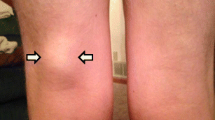Abstract
Muscle hernias result from the protrusion of muscle through acquired or congenital fascial defects. They most often occur in the lower extremities of young adults, typically men. There has been limited description in the literature of this entity in children. Our purpose is to evaluate the demographics, presentation and imaging findings of muscle hernias diagnosed by US in our pediatric patient population. We conducted a retrospective review of all lower extremity muscle hernias diagnosed by US in patients younger than 19 years of age, from January 2001 to March 2011, evaluating the reason for referral, imaging performed before and after US, and subsequent clinical course. Sixteen children were diagnosed with muscle hernia by US, 11 girls and 5 boys, ages 3 to 18 years (mean 13.8). Sixty-nine percent (n = 11) involved the tibialis anterior. Clinical suspicion for muscle hernia was present in seven patients (44%). Of the four cases where MR was performed before US, three were interpreted as normal. In 13 cases (81%), the radiologist reported that dynamic imaging with provocative maneuvers (plantar flexion, standing, squatting) was either necessary or helpful in visualizing the muscle hernia. Four children had surgery to treat symptoms. Muscle hernias are often not suspected clinically in children. US with dynamic imaging and provocative maneuvers is key to diagnosis. US confirmation of a muscle hernia provides a reassuring diagnosis and helps exclude the presence of an aggressive lesion. Surgical intervention is an option for persistent symptoms, but is often not necessary.






Similar content being viewed by others
References
Mellado JM, Perez del Palomar L (1999) Muscle hernias of the lower leg: MRI findings. Skeletal Radiol 28:465–469
Kendi TK, Altinok D, Erdal HH et al (2003) Imaging in the diagnosis of symptomatic forearm muscle herniation. Skeletal Radiol 32:364–366
Bates DG (2001) Dynamic ultrasound findings of bilateral anterior tibialis muscle herniation in a pediatric patient. Pediatr Radiol 31:753–755
Braunstein JT, Crues JV 3rd (1995) Magnetic resonance imaging of hereditary hernias of the peroneus longus muscle. Skeletal Radiol 24:601–604
Ihde H (1929) On muscular hernia of the leg. Acta Chir Scand 65:97–120
Bianchi S, Abdelwahab IF, Mazzola CG et al (1995) Sonographic examination of muscle herniation. J Ultrasound Med 14:357–360
Gokhale S (2007) Three-dimensional sonography of muscle hernias. J Ultrasound Med 26:239–242
Beggs I (2003) Sonography of muscle hernias. AJR 180:395–399
Simon HE, Sacchet HA (1945) Muscle hernias of the leg: review of the literature and report of twelve cases. Am J Surg 67:87–89
Miniaci A, Rorabeck CH (1987) Tibialis anterior muscle hernia: a rationale for treatment. Can J Surg 30:79–80
Wolfort GF, Mogelvang C, Filtzer HS (1973) Anterior tibial compartment syndrome following muscle hernia repair. Arch Surg 106:97–99
Marques A, Brenda E, Amarante MT (1994) Bilateral multiple muscle hernias of the leg repaired with Marlex mesh. Br J Plast Surg 47:444–446
Disclaimer
The authors have no financial interests, investigational or off-label uses to disclose.
Author information
Authors and Affiliations
Corresponding author
Rights and permissions
About this article
Cite this article
Jarrett, D.Y., Kramer, D.E., Callahan, M.J. et al. US diagnosis of pediatric muscle hernias of the lower extremities. Pediatr Radiol 43 (Suppl 1), 2–7 (2013). https://doi.org/10.1007/s00247-012-2347-9
Received:
Revised:
Accepted:
Published:
Issue Date:
DOI: https://doi.org/10.1007/s00247-012-2347-9




